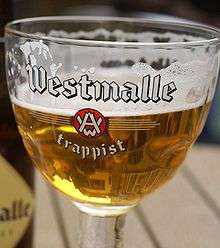Tripel
Tripel is a term used by brewers or people mainly in the Low Countries, some other European countries, and the U.S. to describe a strong pale ale, loosely in the style of Westmalle Tripel.[1] The name 'Tripel' first appeared in the brewery Westmalle, in the 1930s. It was used to name their new beer since they started using a tripled amount of ingredients as before. The style of Westmalle's Tripel and the name was widely copied by the breweries of Belgium,[2] and in 1987 another Trappist brewery, the Koningshoeven in the Netherlands, expanded their range with a beer called La Trappe Tripel, though they also produced a stronger beer they termed La Trappe Quadrupel.[3] The term spread to the U.S. and other countries, and is applied by a range of secular brewers to a strong pale ale in the style of Westmalle Tripel.[4]

History
The term Tripel comes from the Low Countries (now Netherlands and Belgium). According to the Brewmaster at Half Moon Brewery in Bruges, Belgium, the term refers to the amount of malt used to make the beer. A "Tripel" is made with three times the malt in the wort and therefore the outcome is a higher ABV. The word indicates strength by reference to the final gravity of a beer, which roughly corresponds to 3% abv, 6% abv or 9% abv.[5] According to brewing historian Michael Jackson, the first golden strong pale ale associated with the term was brewed by Hendrik Verlinden of the Drie Linden (Three Lindens) brewery in the early 1930s, when ale brewers were looking to compete with the pale lagers from Plzeň.[5][6] Verlinden had an association with the Trappist brewery, Westmalle, assisting them with brewing,[7] and becoming the only secular brewer allowed to carry the Trappist Beer designation.[8] In 1933, Westmalle released a beer under the name Superbier; this was the year after Verlinden produced a golden strong pale ale for his own brewery, the Witkap Pater (now known as Witkap Tripel, produced by the Slaghmuylder Brewery).[9] It was a strong blonde ale and was very likely based on a blonde beer the monks had been brewing sporadically since 1931. In 1956 they renamed it Tripel, and the popularity of that brand ensured the name is still strongly associated with the Westmalle brewery,[10] though both the term Tripel and the style of beer associated with the name (strong pale ale), were in existence before 1956.[5] In 1956, the recipe was modified by the head brewer of Westmalle, Brother Thomas,[11] by the addition of more hops, and it then took on the name Tripel. It has remained essentially unchanged since. Tim Webb in his Good Beer Guide to Belgium says that some of the pre-1956 beers called Tripel were dark, in contrast to modern beers using the term.[12]
References
- "Michael Jackson's Beer Hunter - Beer Styles: Tripel". www.beerhunter.com. Retrieved 2009-07-11.
- The Great Beers of Belgium, Michael Jackson, MMC, 1997, page 226
- The Taste of Beer, Roger Protz, Weidenfeld & Nicolson, 1998, page 140.
- Belgian Ale, Pierre Rajotte, Brewers publications, 1992, pages 31-34
- "Michael Jackson's Beer Hunter - Down on your knees to bless monks' top ale". www.beerhunter.com. Retrieved 2009-07-11.
- Brew Like a Monk: Trappist, Abbey, and Strong Belgian Ales, Stan Hieronymus, Brewers Publications, 2005. ISBN 093738187X
- "Westmalle". www.trappistbeer.net. Retrieved 2009-07-11.
- Witkap Pater Abbey Tripel, Beer of the Month Club, October 2005. Retrieved 11 July 2009.
- "Brewery Slaghmuylder". www.witkap.be. Retrieved 2009-10-17.
- Heavenly Beer, Roger Protz, Carroll &Brown, 2002, page 125
- Michael Jackson. "Michael Jackson's Beer Hunter - Visiting the brand-new Trappist brewery". www.beerhunter.com. Retrieved 2009-07-11.
- Tim Webb: Good Beer Guide to Belgium, 6th edition, p82